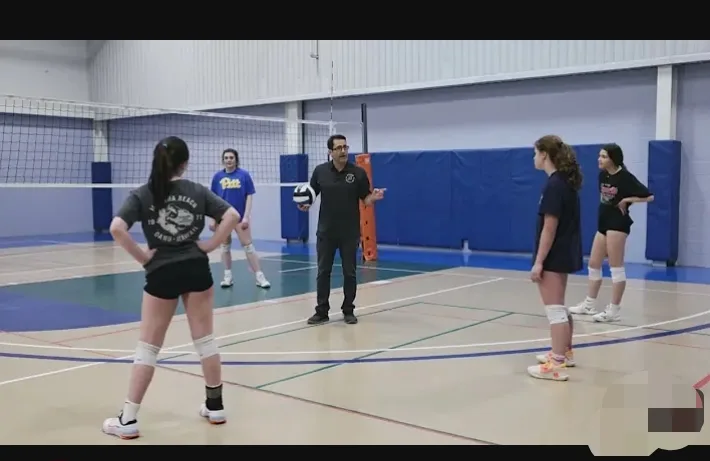Welcome to our guide on volleyball drills for freshman. Volleyball drills for freshmen are part of volleyball training among college students that will prepare them for competitions and improve their volleyball skills.
Whether you are a coach or a new player, this article will provide you with essential drills to build fundamental skills. These exercises will help improve passing, setting, serving, and hitting, ensuring a solid foundation for any freshman volleyball player.
Volleyball Drills for Freshman: High School and College Volleyball Drills
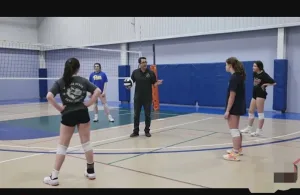
Here are 8 drills for high school and college volleyball that will help improve your passing, serving, setting, and hitting, ensuring a solid foundation for any freshman volleyball player.
1. Warm-Up Drills
Warming up drills are essential, as is the number one exercise to prepare your body for other physical activity. This volleyball drill for freshman increases blood flow to the muscles, reduces the risk of injury, and enhances overall performance. Dynamic stretches improve flexibility and range of motion, which are critical for the various movements in volleyball.
How to do warm-up drills:
a. Jogging and stretching
Jog for 5–10 minutes to get the blood flowing; repeat this in every practice. Follow up with dynamic stretches focusing on the legs, arms, and shoulders.
b. Arm Swings
Stand with your feet shoulder-width apart. Swing your arms forward and backward to loosen the shoulder muscles. This will prepare you for the repetitive motions in volleyball.
Watch more warm-up volleyball drills for freshman below.
Read more:
- Volleyball Bumping Drills for Beginners
- Discover Home Volleyball Training Equipment
- 7 Types of Passes in Volleyball
2. Passing Drills
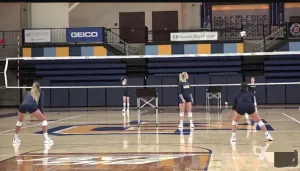
a. Partner Passing
Pair up with a teammate and stand about 10 feet apart. Pass the ball back and forth using your forearms. Focus on maintaining a steady platform and accurate passes.
Partner passing drills help you develop accuracy, control, and consistency in your passes. Good passing is crucial for setting up offensive plays and maintaining ball control.
b. Wall passing
Stand about 5 feet away from a wall. Continuously pass the ball against the wall and try to maintain control. This helps improve your reaction time and consistency.
Wall passing improves reaction time and ball control. By practicing alone, players can focus on their form and consistency without the pressure of a game setting. It also helps in building muscle memory for passing.
See Also:
- Characteristics of a Libero in Volleyball
- Volleyball Ready Position
- Discover Tips for Setting in Volleyball
- Volleyball Strategies for Small Teams
3. Setting drills
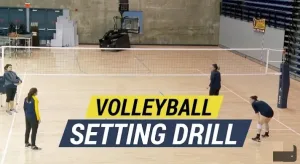
a. Self-Setting
Stand in one spot and set the ball on yourself repeatedly. Aim to keep the ball directly above your head. This drill helps improve your hand positioning and control.
Setting is another core skill in volleyball. Self-setting drills help you develop a feel for the ball and improve your hand positioning. This drill is vital for ensuring accurate and consistent sets during a game.
c. Partner Setting
Pair up and stand about 10 feet apart. Set the ball back and forth, ensuring you use proper technique with your hands and fingers.
Working with a partner allows players to practice setting in a more realistic context. This drill helps in developing timing, communication, and teamwork, all of which are essential for successful plays.
4. Serving drills
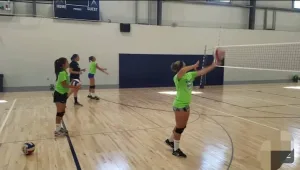
a. Standing serves
Practice serving the ball from behind the end line into the opposite court. Focus on your serving technique, including your toss, contact point, and follow-through.
Serving is the only skill entirely controlled by the player. Practicing standing serves helps you develop a consistent and powerful serve, which is crucial for scoring points and putting the opponent on the defensive.
c. Target Serving
Place targets (like cones or hoops) in different zones of the opponent’s court. Aim to serve the ball to these targets to improve your accuracy and strategic serving.
Target serving enhances accuracy and strategic thinking. By aiming for specific areas of the opponent’s court, players can disrupt the opponent’s formation and create opportunities for their team.
Read More:
- Basic Skills in Volleyball
- Terms in Volleyball with Definitions
- Top 10 Best Volleyball Players of all Time
5. Hitting drills
a. Approach and Swing
Practice your hitting approach without the ball. Start with a slow walk, transition to a run, and jump while simulating a hitting motion. This helps in developing a consistent approach.
A consistent hitting approach is essential for effective attacks. This drill helps players develop a reliable approach, timing, and proper arm swing, all of which contribute to powerful and accurate hits.
b. Hitting Against the Wall
Stand about 10 feet from a wall. Toss the ball to yourself and hit it against the wall. Focus on your arm swing, hand positioning, and follow-through.
Practicing hitting against a wall allows you to focus on your form and follow-through. It helps in developing strength, accuracy, and control, which are crucial for successful spikes.
6. Blocking Drills
a. Solo Blocking
Stand close to the net and practice jumping and reaching over the net as if blocking a hit. Focus on timing your jump and extending your arms.
Blocking is a key defensive skill. Practicing solo blocking helps you develop timing, jumping ability, and arm positioning. Effective blocking can prevent opponents’ attacks and turn the momentum in favor of your team.
b. Partner Blocking
With a partner on the opposite side of the net, practice blocking their hits. This helps improve your reaction time and coordination.
Working with a partner on blocking drills simulates game situations and improves reaction time and coordination. It helps you learn to read the opponent’s hitter and work together to form an effective block.
7. Defensive Drills
a. Digging Practice
Have a coach or teammate hit balls toward you from across the net. Practice digging these balls using proper form, focusing on staying low and keeping your platform steady.
Digging is essential for keeping the ball in play after an opponent’s attack. Practicing digging helps to develop quick reflexes, proper form, and the ability to read the hitter, all of which are critical for a strong defense.
b. Reaction Drills
Set up cones in a random pattern on your side of the court. Have a partner or coach point to different cones and quickly move to touch each one. This improves your agility and quickness.
Quick reactions are crucial in volleyball, where the ball moves rapidly. Reaction drills improve agility, speed, and the ability to anticipate and respond to the ball’s movement, enhancing overall defensive capabilities.
8. Cool-Down Drills
a. Light jogging
Finish with a light jog around the court to bring down your heart rate.
Cooling down helps gradually lower the heart rate and reduce muscle stiffness. It promotes recovery and prepares the body for the next practice or game.
b. static stretching
Perform static stretches focusing on the legs, arms, and back to prevent muscle soreness and promote flexibility.
Stretching after practice helps prevent muscle soreness and improve flexibility. It reduces the risk of injuries and aids in the recovery process, ensuring players stay in optimal condition.
Conclusion
These volleyball drills for freshman can help you develop essential volleyball skills and build a strong foundation for future success. Remember, consistency and proper technique are keys to improvement. Keep practicing, stay focused, and enjoy the game!
Related:
- How to Spike Volleyball with Power
- Volleyball Game or Match: Volleyball Terminology Explained
- Comprehensive Volleyball Rules for Kids
- 4 Best Position in Volleyball

